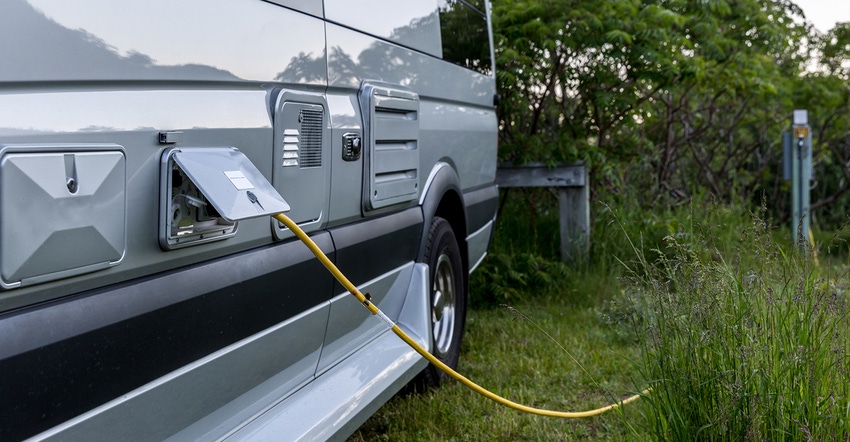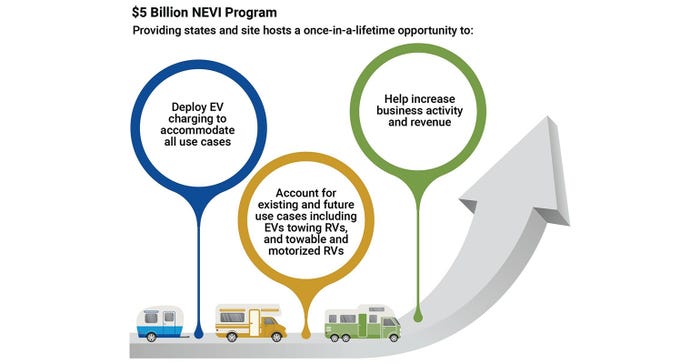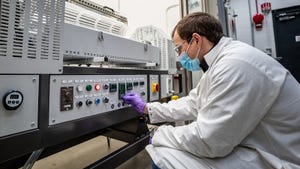Pull-Through Charging: Empowering eRVs and Larger EVs
According to a report by the RV Industry Association, investing in the deployment of pull-through charging infrastructure is essential to accelerate the adoption of electric motorized RVs and larger EVs.

The US is making notable strides toward vehicle electrification, with the federal government dedicating $7.5B until Fiscal Year 2026 to establish public electric vehicle (EV) charging infrastructure. Out of this budget, $5B is earmarked explicitly for DC fast charging, aiming to boost EV adoption and address consumer concerns about range anxiety.
However, a considerable challenge arises as most currently deployed public charging stations follow the traditional pull-in charging design, which doesn't adequately cater to a rapidly expanding range of vehicles. These include EVs towing recreational vehicles (RVs) and trailers, electric-assist RV trailers, electric motorized RVs (eRVs), and other electrified medium and heavy-duty (M/HD) vehicles. To accommodate these diverse EV types and promote their widespread usage, it's essential to consider alternative charging solutions.
To meet the needs of these vehicles and better prepare for the future, a report released by The RV Industry Association and engineering firm Black & Veatch suggests that a portion of the federal funding should be invested in deploying pull-through charging sites. Pull-through charging stations allow vehicles to drive through without reversing, making it easier for larger vehicles and those towing trailers to access the charging infrastructure.

Electric motorized RVs prototypes
The report highlights that the RV industry is making significant investments in eRVs and electric-assist travel trailers, and prototypes of eRVs have already been introduced. “Two eRV prototypes have already debuted: THOR Industries’ Thor Vision Vehicle and Winnebago’s eRV2. Airstream’s eStream is an electric-assist travel trailer prototype.”
It is essential to incorporate pull-through charging infrastructure to facilitate the adoption of these new products and electrified commercial vehicles, such as electric school buses and delivery vehicles. Failing to do so may slow down the electrification of commercial vehicles and require costly retrofits of existing charging stations in the future.
The need for pull-through with existing EVs
Based on the findings, public pull-through charging facilities are currently scarce, with only a few known deployments and plans in the US. A nationwide network of public pull-through DC fast charging stations should be deployed to accelerate and accommodate the growing demand from EV consumers who travel long distances, tow trailers, have lower kilowatt-hour per mile efficiencies, and drive larger than standard vehicles.
“Decision makers, charging companies, and site hosts should deploy charging stations that fit all use cases, including those of RVs. The use case for pull-through charging for RVs already exists with electric vehicles, such as the Rivian R1T and Ford F150 Lightning, pulling towable RVs—which make up 88% of the RV production,” stated RV Industry Association VP of Government Affairs Jason Rano. “Electrified motorized RVs and electric assist trailers are also being developed and need to be considered as these sites are designed not just for today, but for years to come.”
The report shows how EV drivers might need more charging stops when towing trailers and how having a good customer experience when charging might increase the adoption of EVs. The report gives the following example: Although there is not an industry-adopted perspective on how payload affects range, in one case study, a Rivian R1T pickup pulling a 6,500-lb trailer experienced a 50-percent reduction in range. The average range of EV pickups and SUVs in the US is 268 miles. Recreational travel averages 5,000 miles annually, with each trip being approximately 250 miles; therefore, if an EV is towing and realizing a 50-percent reduction in range, the EV would require two or three charging stops during an average trip.
“While pull-through charging will likely require more investment, our economic analysis shows that site hosts could recoup that investment in just a few years,” Rano continued. “When companies are considering the additional investment necessary for pull-through sites, it is important to consider that RVers will need to charge more frequently given the impact that towing has on an electric vehicle's range. Customers with e-RVs and EVs towing RVs will seek out pull-through charging, ultimately spending more time and money at charging sites and the associated amenities.”
The National Park Service has recently debuted an EV charging station locator tool to help EV drivers plan trips to national parks while mitigating range anxiety. However, according to our recent article titled “Is National Park EV Charging Ready for Summer?” there are still not enough chargers to locate.
The RV industry is gigantic
The report indicates that the US RV industry is a massive sector valued at $140B. It is crucial in employing 680,000 Americans, contributing significantly to wages, amounting to over $48B, and generating $13.6B in federal, state, and local taxes. Towables constitute approximately 85 percent of the RV market, and by 2035 it is estimated that 14 percent of towable RV owners will drive EVs (745,551 units).
The report's analysis concludes that investing in pull-through fast-charging networks connecting major travel corridors to recreational destinations and points of interest is crucial to the future of America's EV transition. It will ensure that larger EVs and those towing trailers can travel conveniently and confidently, ultimately promoting the adoption of cleaner transportation options.
About the Author(s)
You May Also Like





